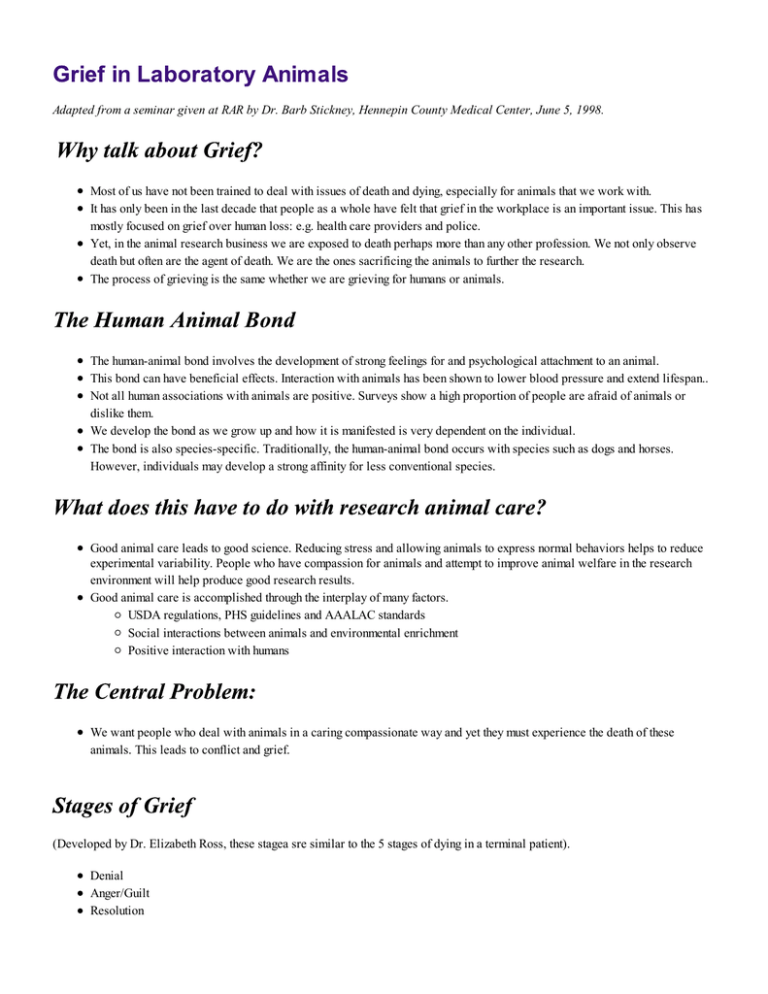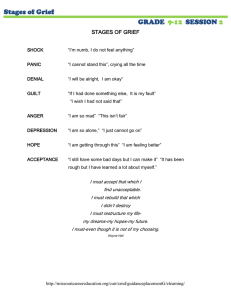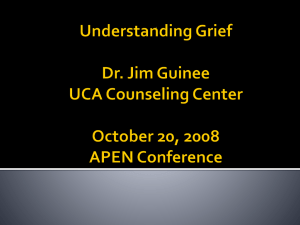Document 13107365
advertisement

Adapted from a seminar given at RAR by Dr. Barb Stickney, Hennepin County Medical Center, June 5, 1998. Most of us have not been trained to deal with issues of death and dying, especially for animals that we work with. It has only been in the last decade that people as a whole have felt that grief in the workplace is an important issue. This has mostly focused on grief over human loss: e.g. health care providers and police. Yet, in the animal research business we are exposed to death perhaps more than any other profession. We not only observe death but often are the agent of death. We are the ones sacrificing the animals to further the research. The process of grieving is the same whether we are grieving for humans or animals. The human-animal bond involves the development of strong feelings for and psychological attachment to an animal. This bond can have beneficial effects. Interaction with animals has been shown to lower blood pressure and extend lifespan.. Not all human associations with animals are positive. Surveys show a high proportion of people are afraid of animals or dislike them. We develop the bond as we grow up and how it is manifested is very dependent on the individual. The bond is also species-specific. Traditionally, the human-animal bond occurs with species such as dogs and horses. However, individuals may develop a strong affinity for less conventional species. Good animal care leads to good science. Reducing stress and allowing animals to express normal behaviors helps to reduce experimental variability. People who have compassion for animals and attempt to improve animal welfare in the research environment will help produce good research results. Good animal care is accomplished through the interplay of many factors. USDA regulations, PHS guidelines and AAALAC standards Social interactions between animals and environmental enrichment Positive interaction with humans We want people who deal with animals in a caring compassionate way and yet they must experience the death of these animals. This leads to conflict and grief. (Developed by Dr. Elizabeth Ross, these stagea sre similar to the 5 stages of dying in a terminal patient). Denial Anger/Guilt Resolution Important features of the grief process: Grief occurs spontaneously, whether or not it is recognized. It is experienced whether the loss is that of an individual or a mere object. The intensity and the length of grief varies between individuals and between objects within the same individual. Denial Euphemisms such as euthanasia, sacrifice, harvesting tissues are used to deny that animals are being killed. Animals are identified with numbers rather than names. It is less personal. Animals are described as data points. Signs of pain or distress in animals may not be identified as such and it may be assumed that animals do not experience these feelings. Some people will make any attempt not to make an attachment to animals that are being used. Dealing with grief through denial helps perpetuate the idea that bonding does not take place. Anger/Guilt If this stage is not expressed, it can become prolonged or intensified. Job stress and frustration can develop. Sadness or depression may occur. This may affect how we interact with coworkers, family and friends. Resolution For people who feel grief some form of resolution is needed to continue to work in this environment. For some it will be to understand the big picture about how the research benefits humans and animals. Understanding the goals of a study can help diffuse the grief. Understanding the ethical principles and regulatory requirements that govern animal research can assure people that animal suffering and overall animal use is minimized. Detachment can be a form of resolution- permanent denial. People may resolve their grief by giving the animal the best life possible while under their care. Outside activities and pets help to resolve grief over animal loss. Some people will take a research animal home, feeling that by "rescuing" one animal and giving it a home they have made a difference. Conclusion Remember that the human-animal bond is individual and expressions of grief are individual. Not everyone feels grief over the same issues; not everyone expresses it in the same way. It is unwise to make assumptions about what other people are feeling. If you have concerns, talk with them about it. Also be prepared to lend a sympathetic ear for others who want to discuss their feelings with you. It is important for all parties involved in animal research: investigators, technicians, animal care staff, veterinary staff, IACUC members and administration to recognize that grief occurs in the animal research setting. People have to be free to discuss issues. While there are no easy solutions, by denying that grief exists, negative effects, such as poor staff morale, high job turn-over and even reduced quality of animal care may occur.



